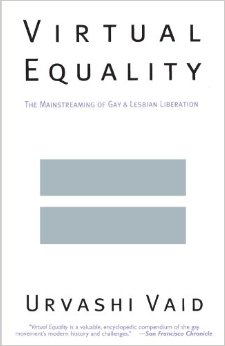Virtual Equality: The Mainstreaming of Gay and Lesbian Liberation by Urvashi Vaid is an examination of the history of the gay and lesbian right/liberation movement, as well as its current trajectory. It takes a close look at gay and lesbian advocacy as it stands now and suggests what some of the problems with the movement are and how it can improve. It’s obviously well-informed and thorough about the political climate of the time. There’s just one problem: it was written in 1995.
It’s maybe an odd choice to pick up a book about the state of queer activism from 20 years ago, but I actually found Virtual Equality an interesting—if not a page-turning—read. For one thing, its look at gay and lesbian (and Vaid does mostly concentrate on gay and lesbian activism, though transgender and bisexual activism is mentioned as well) history is still accurate, and since Vaid lived through the activism of the 80s, it’s described in the kind of detail that I think would be glossed over in a more modern overview.
That detail does sometimes devolve into dense history and statistics that are fairly irrelevant now and are a a slog to get through, but the more general history is fascinating, and reminds me that I have a lot more to learn. Also interesting is seeing some of Vaid’s predictions and recommendations some to pass. For instance, she argues early in the book that gay and lesbian activism at the time had relied too heavily on political activism, ignoring cultural activism. Vaid said that we needed to have more cultural representation in order to turn the tide of public opinion. And, of course, in the late 90s onward, we did get a lot more gay and lesbian representation in media, and the public opinion did shift dramatically!
More than history or a look at “current” 90s politics, however, Virtual Equality has a lot to offer in terms of activist strategy. Vaid has a lot of very practical advice about how to build the movement and make it more effective. One of the more interesting aspects of this is her examination of the Christian Right as a political force. I’ll admit that I saw the Christian Right as a sort of timeless presence in American politics, but Vaid describes its rise as a political force, and also what we can learn from them. Namely, the Christian Right in particular and the Supremacist Right (Vaid’s term) in general are incredibly organized, and Virtual Equality argues that we need to use a similar system to educate activists in order to spread knowledge and strategy.
Overall, reading Virtual Equality reminded me of how much we have to learn from our past so that we don’t keep repeating the same mistakes of previous generations of activists. And yes, the bulk of the criticism that Vaid has is still valid. (I was especially grateful that as a woman of colour activist in a community largely of white men, Vaid offers an intersectional look at sexism and racism within the gay and lesbian community as well as homophobia in the feminist and activists of colour communities.) In fact, I might even say that Vaid’s warning about “virtual equality” versus true equality is even more true today. We need to pass on knowledge of activists so that we don’t have to keep reinventing the wheel, and so that we can continue to make progress.
I did find Virtual Equality to be a slow read: it’s dense and occasionally irrelevant, but it also has so much valuable knowledge packed into it. I would highly recommend this for people who are in queer activism—and even if you’re not, Virtual Equality finishes the book by describing practical ways to get involved in activism and politics, or to take it to the next level if you already are. This gave me a lot to think about: it was well worth the time commitment.

